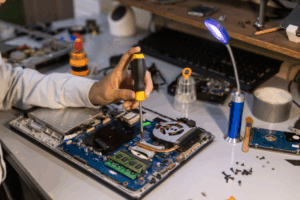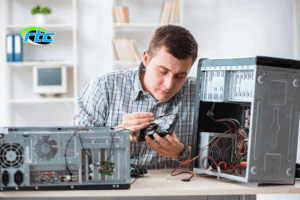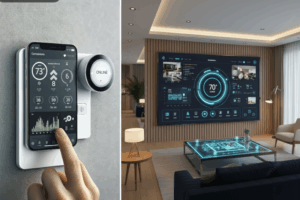When most homeowners think about security systems, they picture the traditional setup: a few cameras around the perimeter, motion sensors at entry points, and maybe a loud alarm that goes off when someone breaks in. While these components remain important foundations of home security, today’s smart home technology offers so much more protection and peace of mind than ever before.
At Reliable Telecom, we’ve helped countless Port St. Lucie families move beyond basic security setups to comprehensive smart home protection that adapts to their lifestyle and provides real-time awareness of what’s happening in and around their homes.
The Limitations of Traditional Security Systems
Traditional security systems are reactive by nature. They sound an alarm after someone has already entered your home, and rely on you or a monitoring service to respond. While this approach has worked for decades, it leaves significant gaps in protection:
- Limited visibility into what’s actually happening around your property
- No proactive threat detection before incidents occur
- Basic monitoring that can’t distinguish between family members, visitors, and potential intruders
- Minimal integration with other home systems and devices
Modern smart home security fills these gaps by creating an intelligent, interconnected system that works proactively to protect your family and property.
Advanced Smart Home Security Components
Intelligent Video Analytics
Today’s smart cameras go far beyond simply recording footage. They use artificial intelligence to understand what they’re seeing:
1. Person Detection and Recognition: Advanced cameras can distinguish between family members, regular visitors, and strangers. Some systems learn to recognize your family’s faces and can send different types of alerts based on who’s detected.
2. Behavioral Analysis: Smart systems can identify unusual behavior patterns, such as someone lingering near your property, attempting to look into windows, or approaching your home at unusual hours.
3. Package and Vehicle Monitoring: Get notified when packages are delivered, when familiar cars arrive, or when unknown vehicles spend time on your street.
Smart Doorbell Integration
Modern video doorbells are communication hubs that do much more than show you who’s at the door:
- Two-way communication lets you speak with visitors even when you’re not home
- Pre-recorded messages can interact with delivery drivers automatically
- Motion zones can be customized to avoid false alerts from street traffic while capturing anyone approaching your entrance
- Integration with smart locks allows you to remotely grant access to trusted visitors
Environmental Monitoring
Smart home security extends beyond intruders to protect against environmental threats:
1. Smart Smoke and Carbon Monoxide Detectors: These devices can pinpoint the exact location of danger, send alerts to your phone even when you’re away, and integrate with other systems to automatically unlock doors or turn on lights during emergencies.
2. Water Leak Detection: Sensors placed near water heaters, under sinks, and in basements can detect leaks before they cause major damage, potentially saving thousands in repair costs.
3. Temperature and Humidity Monitoring: Protect your home from frozen pipes, excessive humidity that can cause mold, or temperature changes that might indicate HVAC problems.
Access Control Systems
Smart locks and access control go far beyond traditional key-based security:
1. Keyless Entry Options: From smartphone apps to fingerprint readers to keypad entry, eliminate the security risks of lost or copied keys.
2. Temporary Access Codes: Create time-limited codes for contractors, house sitters, or guests without compromising your main security codes.
3. Activity Logging: Know exactly who entered your home and when, with detailed logs accessible from your smartphone.
4. Automatic Locking: Ensure your doors are always secured with automatic locking features that engage based on your location or time of day.
Integration and Automation: The Real Power of Smart Security
The true strength of modern smart home security lies not in individual components, but in how they work together as an integrated system.
Scenario-Based Automation
Smart security systems can be programmed to respond to specific scenarios:
“Away Mode”: When you leave home, the system can automatically arm all sensors, adjust camera recording settings, set smart locks, and even adjust lighting to make it appear someone’s home.
“Sleep Mode”: At bedtime, the system can secure all entry points, activate interior motion sensors, and set cameras to monitor key areas while avoiding private spaces like bedrooms.
“Vacation Mode”: Extended away periods can trigger enhanced monitoring, automated lighting schedules that simulate occupancy, and increased sensitivity on all sensors.
Smart Home Ecosystem Integration
Modern security systems integrate seamlessly with other smart home devices:
1. Lighting Systems: Lights can automatically turn on when motion is detected, flash during alarms, or create lighting schedules that enhance security.
2. HVAC Systems: Climate control can be integrated to save energy when you’re away while maintaining optimal conditions for security equipment.
3. Entertainment Systems: Audio systems can be used for two-way communication or to play deterrent sounds when unwanted activity is detected.
Professional Monitoring vs. Self-Monitoring
One of the biggest decisions in smart home security is choosing between professional monitoring services and self-monitoring through smartphone apps.
Professional Monitoring Benefits
- 24/7 response even when your phone is off or you’re unavailable
- Emergency services coordination with local police and fire departments
- Backup communication methods if your internet goes down
- Expertise in threat assessment to reduce false alarm responses
Self-Monitoring Advantages
- Lower ongoing costs without monthly monitoring fees
- Direct control over all alerts and responses
- Immediate awareness of all activity through smartphone notifications
- Customizable response protocols based on your preferences and schedule
Many homeowners find that a hybrid approach works best, using professional monitoring for critical security events while self-monitoring routine activities and environmental factors.
Privacy and Data Security Considerations
As smart home security systems become more sophisticated, protecting your privacy and data becomes increasingly important:
1. Data Encryption and Storage
Ensure your system uses end-to-end encryption for all communications and stores data securely, preferably with options for local storage to maintain control over your information.
2. Camera Placement Ethics
Strategically place cameras to monitor entry points and common areas while respecting privacy in bedrooms and bathrooms. Consider neighbors’ privacy when positioning exterior cameras.
3. Access Control
Regularly review who has access to your security system and revoke access for former house sitters, contractors, or others who no longer need it.
Getting Started with Advanced Smart Home Security
Implementing a comprehensive smart home security system doesn’t have to happen all at once. Here’s a practical approach to upgrading your home protection:
Phase 1: Foundation
Start with smart cameras at key entry points and a smart doorbell with two-way communication capabilities.
Phase 2: Access Control
Add smart locks to main entrances and integrate them with your camera system for comprehensive entry monitoring.
Phase 3: Environmental Protection
Install smart smoke detectors, water leak sensors, and temperature monitoring to protect against non-security threats.
Phase 4: Full Integration
Connect all systems through a central hub that allows for advanced automation and scenario-based responses.
Professional Installation and Support
While many smart home security components are designed for DIY installation, professional setup ensures optimal placement, proper integration, and reliable performance. Professional installers can also provide ongoing support, system updates, and troubleshooting that keeps your security system running smoothly.
At Reliable Telecom, we work with homeowners throughout Port St. Lucie to design and implement smart home security solutions that fit their specific needs, budget, and technical comfort level. Our approach focuses on creating systems that enhance your daily life while providing comprehensive protection.
The Future of Home Security
Smart home security continues to evolve rapidly. Emerging technologies like AI-powered threat prediction, drone-based perimeter monitoring, and integration with community-wide security networks promise even more sophisticated protection in the coming years.
The key to maximizing your security investment is choosing a flexible system that can grow and adapt as technology advances and your needs change.
Take Action: Protecting What Matters Most
Your family’s safety and your property’s security are too important to leave to chance. Whether you’re starting from scratch or upgrading an existing system, the advanced capabilities of modern smart home security offer unprecedented protection and peace of mind.
Ready to move beyond basic cameras and alarms? Contact Reliable Telecom at help@reliable-telecom.net to discuss how we can design a comprehensive smart home security solution tailored specifically to your Port St. Lucie home and lifestyle. Our experienced team will help you understand your options, plan a system that fits your budget, and ensure everything is installed and configured for optimal protection.
Don’t wait until it’s too late – invest in the advanced security your family deserves today. Call Reliable Telecom at (772) 233-4404 to schedule your consultation and take the first step toward comprehensive home protection./isolated-segment.html



